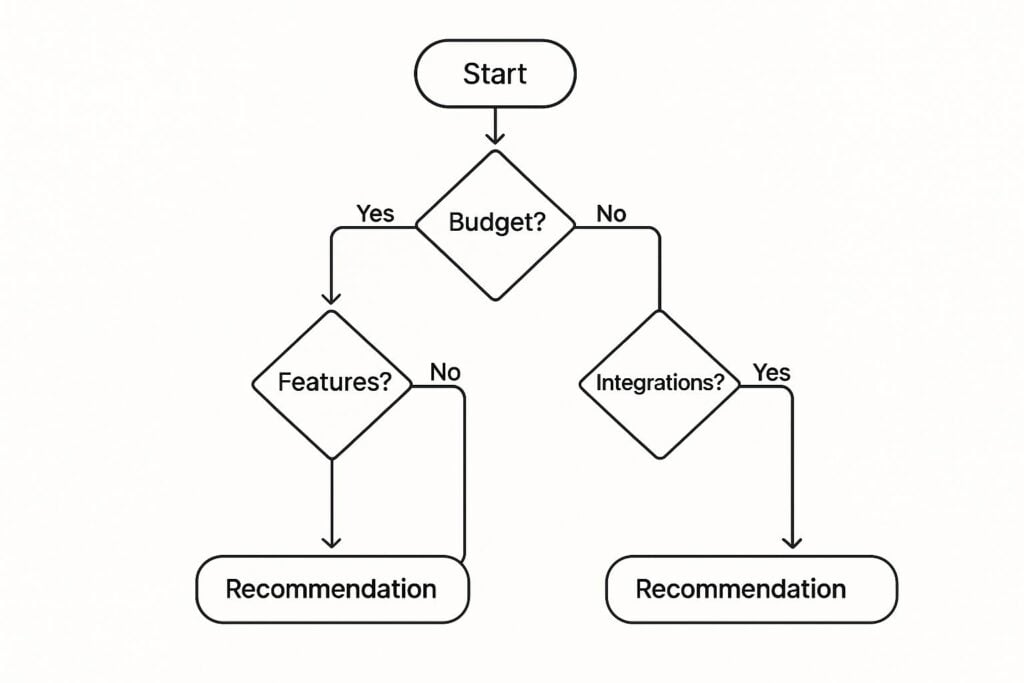The Best Platform for Membership Site Success

Trying to find the best platform for a membership site can feel like drinking from a firehose. The options are endless, and they all seem to promise the world. The good news? Standouts like Kajabi, Circle, and MemberPress have made building a profitable membership easier than ever.
The real question is about finding which one is best for you. It all boils down to what you value most: an all-in-one marketing machine, a deeply engaging community hub, or a completely custom setup you can tweak to perfection.
How to Choose Your Membership Platform
My goal here is to help you cut through the marketing fluff and focus on what actually matters for running a successful membership business. We’re going beyond simple feature lists to look at the core pillars that support a thriving community. Getting this foundation right is one of the most critical decisions you’ll make.
For a complete A-to-Z walkthrough, you can also check out my guide on how to build a membership site from scratch.
When you’re comparing options, everything really comes down to these four pillars:
- Content Delivery: How will you share your courses, videos, and downloads? Is it easy for members to find what they need?
- Community Engagement: What tools do you have to connect members with each other? Think forums, live events, and direct messaging.
- Payment Processing: How simple and secure is it to manage recurring subscriptions?
- Marketing Tools: What’s built-in to help you attract new members and keep them around?
Thinking through this framework will help you zero in on the right platform, whether you’re launching a course, a coaching group, or a niche community for fellow enthusiasts.
Understanding the Membership Landscape
The membership model has absolutely exploded. A staggering 66.8% of sites were created in just the last three years, driven by creators hungry for predictable, recurring revenue. And it’s working. A full 88% of them say they genuinely enjoy running their business.
While business and education are the most popular niches, one challenge unites them all: keeping members engaged month after month.
At its core, the model is simple. You place your valuable, exclusive content behind a paywall, giving access only to paying subscribers.
This diagram shows the basic flow, but the real magic happens in how you deliver that value and foster a sense of belonging. That’s where your platform choice makes all the difference.
A Quick Look at Top Membership Platforms
Before we dive deep, here’s a quick cheat sheet. This table summarizes my top recommendations and who they’re best suited for, giving you a handy reference as you read through the detailed comparisons.
| Platform | Best For | Key Strength |
|---|---|---|
| Kajabi | Course creators who need powerful marketing automation. | All-in-one features including email, funnels, and checkout. |
| Circle | Community-builders who want deep member interaction. | Best-in-class community tools and live event features. |
| MemberPress | WordPress users who demand total design control. | Unmatched flexibility and integration with the WordPress ecosystem. |
| Mighty Networks | Creators building a community with courses and events. | Strong native mobile app and member networking features. |
Now that you have the lay of the land, let’s get into the specifics of what makes each of these platforms tick.
Comparing All-In-One Platforms Kajabi and Kartra
Alright, let’s get into the heavy hitters. Kajabi and Kartra are what we call “all-in-one” platforms. The promise is simple. They handle everything from your website and email marketing to your courses and checkout pages, all under one roof. I’m going to put them head-to-head on the features that actually make a difference when you’re trying to grow a membership.

These platforms are a big deal because they promise to simplify your life. Instead of duct-taping a dozen different tools together, you get one login and one monthly bill. That’s a massive draw if you’re looking for the best platform for a membership site without the tech headaches.
But here’s the thing. They tackle this “all-in-one” idea from slightly different angles, and that’s where the choice gets interesting. I’m going to focus on the key areas that will either make or break your member experience and your ability to scale.
Course Creation and Content Delivery
When it comes to the actual delivery of your content, both platforms are incredibly capable, but they operate on different philosophies. Kajabi feels like a polished, private university, putting the priority on a clean, professional, and intuitive learning experience for your members.
Kartra, on the other hand, is built from the ground up with marketing flexibility in mind. Its course builder is perfectly solid, but its real power shines when you see how it connects to its sales funnel features, letting you build highly customized and automated paths for your members.
Let’s break down their approaches:
- Kajabi’s Strength: It just looks good, right out of the box. You get beautiful, intuitive course themes that make setting up dripped content, quizzes, and certificates feel seamless. It’s designed to impress your students from the second they log in.
- Kartra’s Strength: Kartra gives you the tools for more complex automation within the course itself. For instance, you could automatically tag a user who finishes a specific video, which then triggers an email sequence upselling them to an advanced workshop.
So, if your number one goal is an elegant and straightforward learning environment, Kajabi has the edge. If you want to weave intricate marketing logic directly into your content delivery, Kartra gives you a much bigger toolbox.
Marketing Funnels and Automation
This is where the real battle begins. Both platforms are marketing powerhouses, but their core focus is different. Kartra was built by marketers, for marketers, and it shows. Its visual campaign builder is an absolute standout feature.
You can literally map out an entire customer journey on a drag-and-drop canvas, connecting everything from emails and tags to page visits and automations. It’s incredibly powerful for creating complex funnels that react to what a user does in real-time. For example, you can create a rule that says, “If a member watches 75% of the welcome video but doesn’t join the community forum, send them a personalized invitation email.”
Kajabi’s marketing tools, which they call Pipelines, are more template-driven and streamlined. They offer pre-built funnels for common scenarios like product launches, freebie opt-ins, and webinar registrations. This makes getting started much faster and easier if you aren’t a seasoned marketing pro.
Key Takeaway: Kartra offers deeper, more granular control over your marketing automation, making it a dream for experienced marketers. Kajabi simplifies the whole process with proven templates, making it far more accessible for creators who just want results without a massive learning curve.
Community and Member Engagement
For most memberships, community is the glue that keeps people sticking around, and both platforms have tools to help you build one. Kajabi recently rolled out its Community 2.0 product, which is a massive upgrade. It now includes live meetups, challenge features, and a sleek, modern interface that feels much more like a private social network.
Kartra’s community feature is more of a traditional, old-school forum. It gets the job done for simple discussions but lacks the immersive, interactive feel of Kajabi’s newer community hub. While you can certainly foster engagement in Kartra, it doesn’t feel like it’s a primary focus for them.
If member-to-member interaction is a core part of your value proposition, Kajabi now has a clear and decisive advantage here. It gives you the tools to create a space that feels alive and interactive, which is absolutely critical for long-term member retention.
Analyzing Community-First Platforms: Mighty Networks vs. Circle
So far, we’ve been looking at platforms where content and marketing tools are the main event. But what if building a vibrant, interactive community is your number one goal? If that’s you, then you absolutely have to know about Mighty Networks and Circle.
These two platforms flip the traditional membership model on its head.

They were built with the community at the very core of the experience. Courses and content are treated as supporting elements, not the main attraction. This community-first approach completely changes the dynamic of your membership, and it can be incredibly powerful for keeping members engaged and happy. Let’s dig into how they pull this off.
The Philosophy of Community-First Design
Mighty Networks and Circle operate on a simple belief: connection drives retention. The idea is that people might come for your content, but they will absolutely stay for the community. Everything in their design is meant to spark member-to-member interactions and make your space feel like a lively, private social network.
This is a huge departure from platforms where the “community” is just a simple forum tacked onto a course library. Here, the community hub is the main dashboard. The first thing members see are conversations, upcoming events, and other members, which naturally encourages them to jump in and participate.
And the data backs this up. It turns out that members who regularly connect with their peers are three times more likely to renew their subscriptions. That’s why platforms like these emphasize features like direct messaging, lively forums, and live events. They’re building a true sense of belonging. This strategy is fast becoming a favorite for boosting retention, especially in the age of micro-communities. You can find more insights on building lasting communities at WP-Tonic.com.
Circle: The Modern Community Platform
Circle has quickly become a top choice for creators who want a sleek, modern space for their people. It feels like a polished combination of a private Facebook Group and a Slack channel, but it’s all on your own branded platform. The user interface is clean, intuitive, and just a joy to use.
Its real strength is in how it organizes conversations and events.
- Spaces: You can create different “Spaces” for specific topics, courses, or member groups. This is brilliant for keeping discussions organized and preventing the main feed from feeling like a chaotic firehose of information.
- Live Events: Circle has excellent built-in tools for hosting live streams, workshops, and member calls right inside the community. You don’t have to juggle a third-party tool like Zoom.
- Member Profiles: The profiles are rich and detailed, helping members find and connect with others who share their interests. This is a massive driver of organic, natural engagement.
Circle excels at creating a focused, professional environment. It’s the best platform for membership site owners who want to offer a premium, organized community experience alongside their courses or coaching.
Mighty Networks: The All-in-One Community Engine
Mighty Networks takes a slightly different tack by aiming to be a true “all-in-one” for community-centric businesses. It combines community features, online courses, events, and even its own payment system into a single, cohesive package.
But its biggest differentiator is its exceptional native mobile app.
While Circle has a great mobile app, the one from Mighty Networks (which can be branded as your own with their Pro plan) is consistently praised for its top-notch performance and user experience. This makes your community incredibly accessible, letting members engage from anywhere. It feels less like a website you visit and more like a dedicated app for your brand.
For example, a fitness coach could run their entire business here. Members could share workout progress in a central feed, access workout videos in a dedicated “Courses” area, and join live Q&A sessions, all within one seamless mobile app. This creates a powerful, self-contained ecosystem that keeps members coming back day after day.
Ultimately, the choice often comes down to polish versus power. Circle offers a more refined, elegant design, while Mighty Networks provides a slightly more comprehensive feature set with a standout mobile experience.
Using WordPress with MemberPress and WishList Member
For creators who crave total control, building your membership site on WordPress is the undisputed king. It’s the difference between owning your own house and renting an apartment. You can paint the walls any color you like, knock down a few, or build an extension whenever you feel the need. If that kind of freedom sounds good to you, this is your path.

I’m going to put two of the most powerful WordPress membership plugins, MemberPress and WishList Member, head-to-head. These tools are designed to bolt onto a standard WordPress site and turn it into a full-blown membership machine. We’ll look at flexibility, how they protect your content, and most importantly, how they play with the other tools you rely on.
The biggest draw of the WordPress route is that you own everything. Your content, your member data, your design, your rules. But with great power comes great responsibility. You’re on the hook for hosting, security, updates, and general maintenance. It’s the classic trade-off: ultimate control versus plug-and-play simplicity.
MemberPress: The All-in-One WordPress Solution
MemberPress has earned its reputation as the go-to choice for a reason. It’s known for being incredibly powerful yet surprisingly straightforward to get up and running. Most people can install it, configure their membership tiers, connect payment gateways, and start locking down content in under an hour.
It’s an incredibly solid choice for anyone looking for the best platform for a membership site built on WordPress. One of its best features is how it handles content protection. You can restrict access to pages, posts, categories, tags, and even individual files with just a few clicks. It just works.
Another huge win for MemberPress is its built-in course-building addon. This lets you create and sell structured online courses, complete with lessons and quizzes, all from the same dashboard. This is a massive plus if you want to avoid buying and managing a separate Learning Management System (LMS) plugin.
WishList Member: The Power Player for Complex Rules
WishList Member has been in the game for a long time, and it shows in its sheer depth of features. If you’re dreaming up a complex membership with tons of different levels, content bundles, or pay-per-post access, WishList Member provides the granular control you need to pull it off.
It’s a true power user’s tool. For instance, you can set up “sequential upgrades,” where a member is automatically moved from a bronze to a silver plan after 30 days. You can also get creative with content protection, like showing a “teaser” of a post to non-members to entice them to sign up.
My Takeaway: Think of MemberPress as the user-friendly powerhouse that handles 90% of what most creators need, and it does it beautifully. WishList Member is the specialist you bring in when your membership logic gets really complicated and you need maximum flexibility above all else.
Integrations and The True Cost
With WordPress, no plugin is an island. Your membership plugin has to communicate seamlessly with your email marketing service, payment gateways, and maybe a forum plugin. Both MemberPress and WishList Member boast a massive library of integrations, so this is rarely a deal-breaker for either one.
The “true cost” of a WordPress setup is something you need to budget for. While the plugin itself is a one-time or annual fee, your total investment will also include:
- Web Hosting: A recurring monthly or yearly expense.
- A Premium Theme: For a professional look and feel.
- Other Essential Plugins: For things like SEO, backups, and security.
These costs add up, but they also give you the freedom to hand-pick the best tools for every single job. If you’re ready to take the reins, the WordPress path offers unmatched potential. To get a feel for the entire process, check out our guide on how to launch a membership site successfully.
Matching A Platform To Your Business Model
We’ve covered a lot of ground comparing features, so let’s bring it all back to what matters most: your business. Finding the best platform means picking the one with the right features. The key is to find the tool that perfectly aligns with your specific goals.
So, how do you make the final call? It really comes down to your business model. Are you primarily a course creator focused on selling knowledge? Or maybe a coach building a high-ticket mastermind where connection is key? Let’s get practical and match these goals to the right platform.
For Course Creators And Educators
If your main product is structured learning content, like courses, workshops, or tutorials, your platform needs to nail content delivery. You want an experience for your students that is smooth, professional, and easy to follow.
This means you should prioritize platforms with a strong Learning Management System (LMS). Look for features like course progress tracking, quizzes, certificates, and the ability to drip content over time. In this case, an all-in-one platform like Kajabi or a powerful WordPress setup with MemberPress is often the ideal choice. They are built to make your educational content shine.
For Community Builders And Networkers
What if your value is about connection instead of content? If you’re building a mastermind, a support group, or a networking hub, the community tools are everything. People are joining to interact with you and, more importantly, with each other.
For this model, a clunky forum tacked onto a course platform just won’t cut it. You need a platform designed to spark conversations. This is where community-first options like Circle and Mighty Networks are in a league of their own. Their entire design pushes members to connect through live events, discussion spaces, and member profiles.
The core idea is to choose a platform that makes your main offering the star of the show. Don’t try to force a community-focused business onto a platform that treats community as an afterthought.
This simple decision tree can help you visualize the process, starting with your budget and moving through features and integrations.

As you can see, your budget often dictates your initial options, but your feature needs are what truly narrow down the field.
To help you map your business goals to a specific platform type, here’s a quick reference table.
Platform Recommendations Based On Your Goals
Use this decision-making table to match your primary business objective with the most suitable platform type.
| If Your Primary Goal Is… | Consider This Platform Type | Top Platform Examples |
|---|---|---|
| Selling structured online courses | All-in-one or WordPress LMS | Kajabi, Thinkific, MemberPress |
| Building an interactive community | Community-first platform | Circle, Mighty Networks, Heartbeat |
| Maximum design & feature control | Self-hosted WordPress | MemberPress, WishList Member |
| Offering digital downloads & content | All-in-one or WordPress | Podia, MemberPress |
| Coaching or mastermind groups | Community-first platform | Mighty Networks, Circle |
| Simplest all-in-one experience | Hosted all-in-one platform | Kajabi, Podia |
This table should give you a clear starting point based on what you’re trying to achieve, making the rest of the decision-making process much smoother.
For The Customization Experts
Finally, there are the creators who want total control. If your business model is unique and you need to fine-tune every aspect of the member experience, from the design to specific integrations, then WordPress is your answer. With plugins like MemberPress or WishList Member, your only limit is your imagination.
This path gives you ultimate freedom, but it comes with a trade-off. You are responsible for the technical side of things. For many, though, the control is well worth it.
No matter which platform you go with, a solid email marketing strategy is non-negotiable for keeping members engaged. To find the right fit for your new setup, check out these best email marketing services and platforms.
The entire subscription economy is growing at a massive rate, with a projected compound annual growth of nearly 71% by 2025. This shift shows that customers crave ongoing value, making your platform choice more important than ever.
Ultimately, making the right choice now saves you from a painful migration process later. For a deeper dive into these options, you can read our complete breakdown of the best membership site platform choices.
Answering Your Top Membership Platform Questions

Choosing a membership platform is a big commitment, so it’s completely normal to have a few questions rattling around before you make a final call. After walking hundreds of creators through this exact decision, I’ve seen the same concerns pop up time and time again.
I’ve put this section together to tackle those common questions head-on. My hope is to give you that last piece of clarity you need to move forward with confidence and pick the perfect home for your business.
Can I Switch Membership Platforms Later On?
Yes, you absolutely can switch platforms down the road. But I have to be honest with you. It’s a massive headache. Migrating all your members, content, and payment data from one system to another is technically complex and incredibly time-consuming.
This is exactly why spending a little extra time on your initial decision is so critical. You really want to choose a platform that aligns with your long-term vision from day one.
If you have big plans to scale, make sure your chosen platform can grow with you. If you decide to start with a simpler, more budget-friendly option, just do yourself a favor and double-check that it allows you to easily export your member data. That one feature will be an absolute lifesaver if you ever need to pack up and move.
How Much Does It Really Cost to Run a Membership Site?
That’s a great question, and the answer really depends on the path you choose. You should look at the total cost of ownership, not just the sticker price of the platform itself.
All-in-one platforms like Kajabi come with a higher monthly fee, but they bake in nearly everything you need. That includes email marketing, landing pages, video hosting, and more. The WordPress route can seem cheaper at first glance with a one-time or annual plugin purchase, but the other costs add up fast.
For a WordPress site, you’ll also need to budget for:
- Quality Web Hosting: A recurring monthly or annual expense that you can’t skimp on.
- A Premium Theme: To give your site a professional look and feel that inspires trust.
- Email Marketing Service: A separate tool like ConvertKit or ActiveCampaign.
When you add it all up, the WordPress path can easily match or even exceed the cost of a hosted platform. And don’t forget to budget for payment processor fees. No matter which platform you use, services like Stripe or PayPal will typically take around 2.9% + $0.30 from every single transaction.
Do I Need Technical Skills to Set Up a Membership Site?
This one is a huge factor in making the right decision for your own comfort level, and it really depends on the platform you choose.
Hosted SaaS platforms like Kajabi or Circle are specifically designed to be user-friendly. They handle all the backend stuff for you, like the hosting, security, and software updates. This lets you focus on creating content and engaging with your members. They require very few technical skills to get started.
The WordPress approach definitely requires more technical confidence. You don’t have to be a professional developer, but you will be responsible for setting up your own hosting, installing plugins, performing updates, and troubleshooting issues when they pop up. If that sounds like your worst nightmare, a hosted platform is a much better choice.
What Is More Important: Content or Community?
This is a classic debate, and the answer depends entirely on your specific business model and the promise you make to your members. There’s no single right answer, but your choice of platform should absolutely reflect your primary focus.
For some businesses, like an online course library, high-quality, exclusive content is the main event. People join to learn a specific skill or access a unique resource. In this scenario, your platform needs to be a powerhouse at content delivery.
For others, like mastermind groups or hobby communities, the connections between members are the main reason people stick around. The content might be a nice bonus, but the real value is in the network and the shared experience.
The very best membership sites find a healthy balance between both. However, your platform choice should lean heavily toward your core offer. If community is the heart of what you do, choose a platform built for that, like Circle or Mighty Networks. If it’s all about the content, a powerful LMS like Kajabi or a custom WordPress setup is probably a better fit.




![How to Launch a Membership Site Using Squarespace [Step By Step Guide]](https://learnstream.io/wp-content/uploads/2024/11/image-768x433.png)

